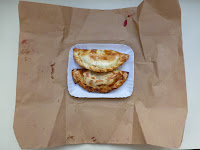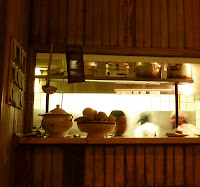A Chinese restaurant run by Peruvians may seem like a strange mingling of cultures but it is not altogether uncommon in La Ciudad de la Furia (Buenos Aires' pseudonym according to the 80s Argentine rock band, Soda Stereo). We are after a few drinks and some hefty food to soak up the cheap wine we have just sophisticatedly sipped from plastic cups, at the opening of an art exhibition in Centro Cultural Borges.
 We choose two rice dishes to share between the three of us, one with chicken and mushrooms, one egg-fried with vegetables. I am keen to try the dish named Felicidad para todos (translated helpfully into English on the menu, 'Happiness for all') for novelty's sake but the high price tag suggests an insurmountable expanse of food which would necessitate a doggy bag or three. I make a mental note to make a return visit with five or six hungry friends, on the proviso that what we eat tonight is decent. Fabricio orders the dishes, asking for three plates for serving, big portions, and for the food to be made with 'mucho amor', to which the pint-sized no-nonsense Peruvian waitress gives a bemused smile. He also tells her about my blog-writing endeavours in a bid to blag extra generous portions and/or free drinks, but she remains utterly unmoved, and judging by how busy the place is, she has no reason to be otherwise.
We choose two rice dishes to share between the three of us, one with chicken and mushrooms, one egg-fried with vegetables. I am keen to try the dish named Felicidad para todos (translated helpfully into English on the menu, 'Happiness for all') for novelty's sake but the high price tag suggests an insurmountable expanse of food which would necessitate a doggy bag or three. I make a mental note to make a return visit with five or six hungry friends, on the proviso that what we eat tonight is decent. Fabricio orders the dishes, asking for three plates for serving, big portions, and for the food to be made with 'mucho amor', to which the pint-sized no-nonsense Peruvian waitress gives a bemused smile. He also tells her about my blog-writing endeavours in a bid to blag extra generous portions and/or free drinks, but she remains utterly unmoved, and judging by how busy the place is, she has no reason to be otherwise.
I have been warned by my two companions, who are regulars at this straight up no-frills eatery, that under no circumstances should I try any seafood or fish on the menu; the only things that are safe are vegetarian or meat-related. Indeed, as a steaming pile of squid rings are served up at the next table Enrica pulls a mock-concerned face from across the table, conspiratorially whispering 'suerte!' (good luck) under her breath before laughing. This does not fill me with any deep sense of confidence in the food I am about to consume, but if my dining companions are regular and loyal patrons then I am in good hands, right?
 We choose two rice dishes to share between the three of us, one with chicken and mushrooms, one egg-fried with vegetables. I am keen to try the dish named Felicidad para todos (translated helpfully into English on the menu, 'Happiness for all') for novelty's sake but the high price tag suggests an insurmountable expanse of food which would necessitate a doggy bag or three. I make a mental note to make a return visit with five or six hungry friends, on the proviso that what we eat tonight is decent. Fabricio orders the dishes, asking for three plates for serving, big portions, and for the food to be made with 'mucho amor', to which the pint-sized no-nonsense Peruvian waitress gives a bemused smile. He also tells her about my blog-writing endeavours in a bid to blag extra generous portions and/or free drinks, but she remains utterly unmoved, and judging by how busy the place is, she has no reason to be otherwise.
We choose two rice dishes to share between the three of us, one with chicken and mushrooms, one egg-fried with vegetables. I am keen to try the dish named Felicidad para todos (translated helpfully into English on the menu, 'Happiness for all') for novelty's sake but the high price tag suggests an insurmountable expanse of food which would necessitate a doggy bag or three. I make a mental note to make a return visit with five or six hungry friends, on the proviso that what we eat tonight is decent. Fabricio orders the dishes, asking for three plates for serving, big portions, and for the food to be made with 'mucho amor', to which the pint-sized no-nonsense Peruvian waitress gives a bemused smile. He also tells her about my blog-writing endeavours in a bid to blag extra generous portions and/or free drinks, but she remains utterly unmoved, and judging by how busy the place is, she has no reason to be otherwise.
Inbetween talk about Maradona, greasy spoon cafes in London, dancing tango, and the exhibition we have just seen, we hungrily ladle the rice onto our plates, top up our beer glasses, eat and drink. The only obvious concession to Peruvian cuisine is the tiny saucer of salsa picante which sits like an afterthought beside the soy sauce and is reminiscent of the kind you get in Peruvian restaurants to dip bread in at the beginning of a meal. It all tastes good, not astoundingly so, but freshly prepared and made with love, as requested.
The total bill including a generous tip comes to a total of ninety pesos (less than £14) for the three of us, this is clearly the place that Argentine inflation forgot. Sated and happy we go off into the night in the direction of a milonga, sustained by our full bellies and the expectations of the night.


















